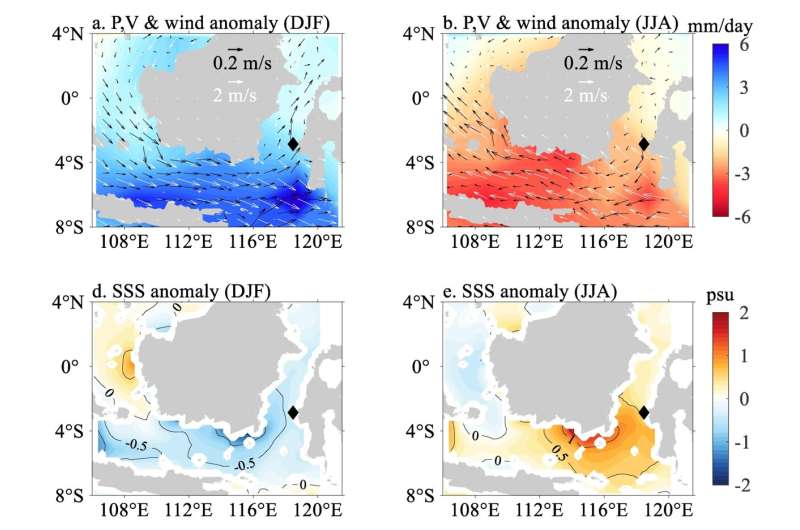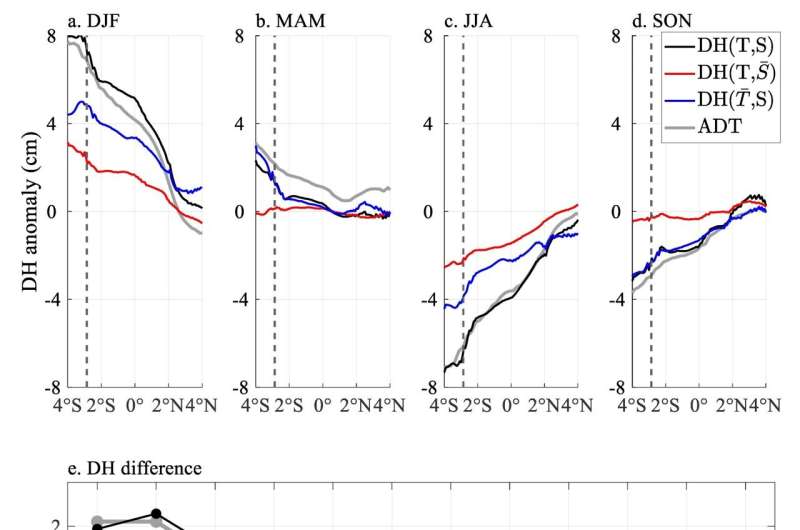This article has been reviewed according to Science X's editorial process and policies. Editors have highlighted the following attributes while ensuring the content's credibility:
fact-checked
peer-reviewed publication
trusted source
proofread
How salinity affects seasonal variability of the Makassar Strait throughflow

The Makassar Strait throughflow (MST) accounts for approximately 77% of the total volume transport of the Indonesian throughflow (ITF), and it influences mass and heat exchanges between the Indo-Pacific basin and global climate.
The "freshwater plug" hypothesis about the seasonal variability of MST is extensively cited in studies. However, there has long been a dearth of quantitative research elucidating both the existence and specific contribution of salinity effect.
Recently, an international team led by Prof. Hu Shijian from the Institute of Oceanology of the Chinese Academy of Sciences (IOCAS) has quantified the contribution of salinity effect on the seasonal variability of MST with long-term observations and high-resolution numerical simulations, and found that the freshwater forcing and salinity effect dominate the seasonal change of MST.
The study was published in Geophysical Research Letters on Oct. 31.
Since MST is controlled by pressure gradient along the Makassar Strait, the researchers focused on the role of salinity change in meridional gradient of steric height in the Makassar Strait.
They compared the in-situ observations from Arlindo and Monitoring ITF with high-resolution reanalysis, and found that MST is a southward current with significant seasonality.

In boreal winter, a weak northward current is present in the upper layer of the southern Makassar Strait, which is subject to the northward dynamic height gradient influenced by both the halosteric and thermosteric components.
Quantitatively speaking, the halosteric dynamic height closely associated with the seasonal cycle of salinity contributes 69.6% ± 11.7% to the total seasonal variability of the sea surface dynamic height gradient within the Makassar Strait.
The northwest monsoon leads to an increasing in freshwater transport through the Karimata Strait and increasing of local precipitation in the Java Sea, which further causes a decline of salinity and an anomalous northward pressure gradient in the Makassar Strait, and hence resulting in a weakened throughflow. The opposite occurs in boreal summer.
"Our study not only confirms the importance of freshwater plug and salinity effect mechanism in the seasonality of MST, but also deepens our understanding of the ITF dynamics," said Prof. Hu.
More information: Xi Lu et al, Quantifying the Contribution of Salinity Effect to the Seasonal Variability of the Makassar Strait Throughflow, Geophysical Research Letters (2023). DOI: 10.1029/2023GL105991
Journal information: Geophysical Research Letters
Provided by Chinese Academy of Sciences





















